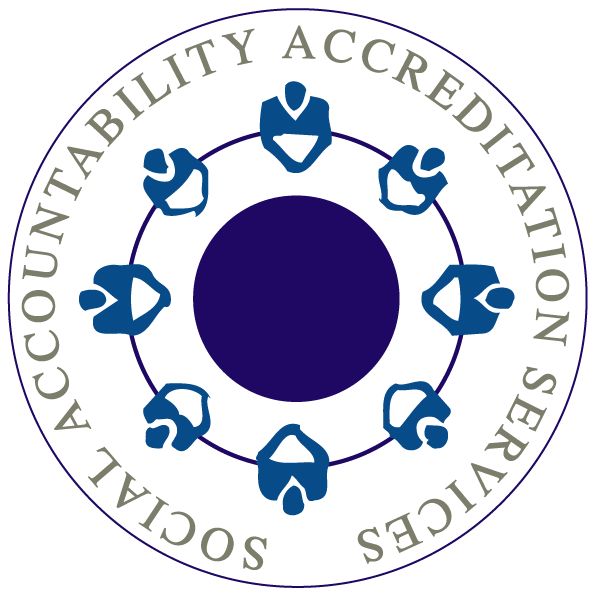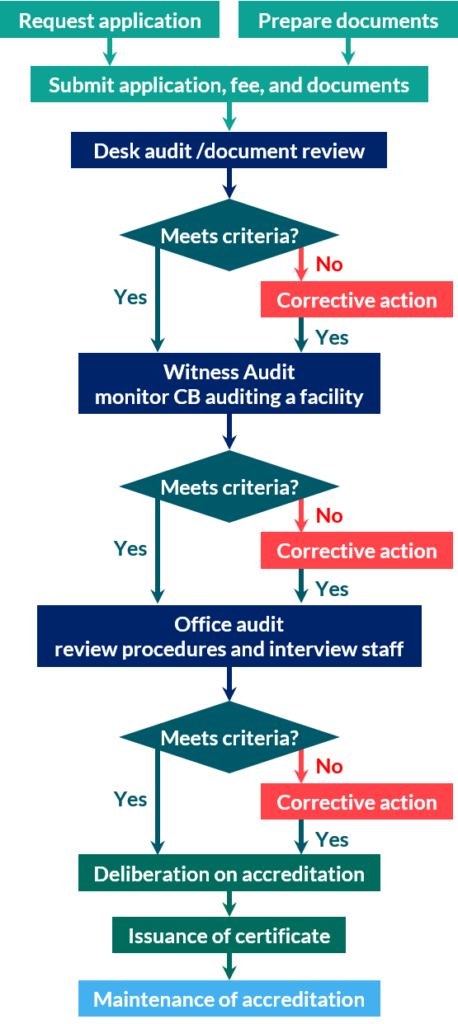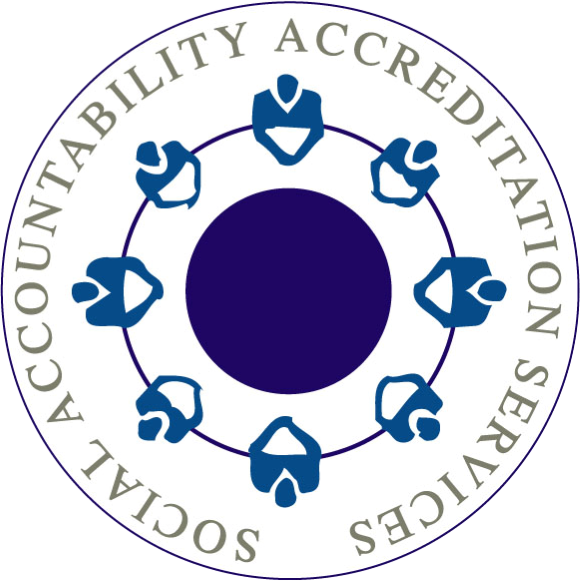Apply for SA8000 Accreditation
Overview of the Accreditation Application Process
Social Accountability Accreditation Services (SAAS) assures quality and reduces risk in the SA8000 certification system by providing oversight and accrediting auditing companies delivering SA8000 certification audits. SAI and other stakeholders recognize only those SA8000 certificates issued by SAAS-accredited certification bodies (CBs) as legitimate.
To become accredited to conduct SA8000 audits, CBs undergo a rigorous initial and ongoing assessment process to assure they consistently conduct reliable audits according to the SA8000 audit methodology. The initial accreditation process includes an assessment by SAAS through document review, on-site office audits, and observation of auditors conducting SA8000 audits.
Please be aware of the temporary moratorium by SAAS on accepting new applications for accredited Certification Bodies seeking to deliver SA8000 audits.
Below is an overview of the initial accreditation process. Learn more by downloading the Description of the Initial Accreditation Process by SAAS for SA8000.
If your auditing company is interested in applying for accreditation, please review this page and all associated documents carefully. If you still have questions, you may contact Lisa Bernstein.
Note: Once SAAS receives a completed application for accreditation, the initial accreditation process can take anywhere from 6-18 months, with an average timeframe of 12 months.

1. Download an Application Package
The application package details all requirements and documents needed to establish and implement an effective SA8000 certification system.
2. Document and procedure preparation
CBs interested in conducting SA8000 audits must conform to requirements set out in SAAS procedures and ISO/IEC 17021-1:2015. All SAAS Procedure 200 and 201 documents are available in the SAAS Document Library.
SAAS Procedure 200 and Procedure 200A specify requirements for conducting SA8000 audits and assessing organisations against the SA8000 Standard and for performing management system-maturity declarations, respectively. These procedures describe the processes that CBs and their audit team members apply to consistently conduct SA8000 audits.
SAAS Procedure 201A and Procedure 201B describe SAAS accreditation and assessment requirements and SAAS operational processes, including for granting accreditation, and SAAS expectations for CBs, including processes for maintaining SA8000 accreditation. They also define the rights and responsibilities of SAAS and of accredited CBs. These documents include more details about:
- Routes to accreditation;
- Accreditation application process;
- Estimated number of audit days for initial accreditation;
- Process requirements for accreditation;
- Initial accreditation assessment;
- Continuance of accreditation;
- Reaccreditation; and
- Complaints management
ISO/IEC 17021 describes principles and requirements for competent, consistent, and impartial management system audit and certification activities (e.g. quality management systems or environmental management systems) and for bodies providing these activities. CBs interested in accreditation by SAAS must meet these requirements as well.

Additional Resources
The following resources may provide additional context or details to help you prepare a successful SA8000 certification system to apply for accreditation.
- SA8000:2014 Standard and Related Documents
- SA8000:2014 Procedure 200 Checklist #2
- SA8000:2014 Procedure 200A Checklist #3
- SA8000:2014 Procedure 201B Checklist #4
- SA8000:2014 Procedure 201A and ISO 17021-1 Checklist #5
- SA8000 Auditor Competence Matrix
- Unannounced SA8000 Audits
- Anti-Bribery Policy and Template
- Accreditation Country Risk Assessment
Still have questions or want to provide feedback? Complete the SA8000:2014 Procedures: Stakeholder Feedback and Clarification Request Form and submit to saas@saasaccreditation.org.
3. Application submission and SAAS document review
After preparing all the necessary documents and procedures, submit the application form and invoicing details for the initial accreditation application fee (see fee schedule) to the SAAS Head Office by contacting Lisa Bernstein. Once the application form and fee have been received, applicants will be invited to submit supporting documents, along with the procedures, policies, and work instructions, completed Checklists 2-5, and the Auditor Competency Matrix (listed above) to SAAS.
Note: SAAS will not accept an application unless it contains ALL required documentation noted above, along with payment of the application fee. Be advised that SAAS will not accept or review checklists if the applicant does not include reference document names and/or clause numbers in the form where indicated.
Upon receiving an application, SAAS staff will confirm it is complete and assign a SAAS lead auditor to review. This review is to confirm that the applicant has a documented certification management system that meets the requirements set forth by SAAS. This process takes approximately two days of the auditor’s time, which is billed to the applicant.
Accredited CBs will need to pay additional fees for required training and licensing. Learn more about fees for SAAS-accredited CBs.
4. Witness audit
If the documents received meet the criteria set out for accreditation, SAAS will proceed to schedule a witness audit of the applicant. In this stage, SAAS auditors observe SA8000 auditor(s) from the applicant CB as they audit an organization seeking SA8000 certification. The purpose of the witness audit is to assess effectiveness of the applicant CB’s auditing system and determine the competence level of its auditors. The witnessed audits must be initial certification audits; therefore, the applicant CB must have a client willing to go through the SA8000 certification process only to become certified if and when the accreditation process is complete. The witness audit may result in the issuance of non-conformities to the applicant CB, which must be addressed prior to continuing the accreditation process.
5. Office audit
Office audits are scheduled pending satisfactory results of the document review and witness audit. The purpose of the office audit is to assess the effectiveness of the applicant CB’s auditing system within its defined scope. During the office audit, SAAS accreditation auditors review the applicant CB’s procedures, documents, records, and files and conduct interviews with staff. The office audit may result in the issuance of non-conformities to the applicant CB, which must be addressed prior to continuing the accreditation process.
6. Final report and audit team recommendations
Once the office and witness audits are complete, the audit team drafts their final report and accreditation recommendations, which are reviewed by the Accreditation Review Panel (ARP). The ARP then has 30 days to make their own recommendation on whether to grant or refuse accreditation. At that time, the SAAS Executive Director makes a final decision on accreditation for the applicant CB.
Additional Resources
- SAAS Sample Accreditation Agreement
- SAAS Sample Accreditation Certificate
- SA8000 Certified Facilities Reporting Form & Instructions
- SAAS Complaint & Appeals Guidelines
7. Maintenance of accreditation
Accreditation is valid for a period of four years, during which SAAS conducts a minimum of two annual surveillance audits (both office and witness audits) of the accredited certification body to verify continuing compliance with the accreditation criteria. The number of surveillance audits is determined based on the number of certifications granted by the CB and the CB’s scope of accreditation.
8. Reaccreditation
At the end of the four-year cycle, the CB begins the reaccreditation process, which includes repeating steps 3-6 above.
9. Scope Expansion
At initial accreditation, Certification Bodies are granted accreditation within a limited geographic scope. Should a CB wish to expand its geographic scope to deliver audit activity into additional countries, the CB shall complete and submit the documents listed below, along with supporting details as per the Checklist.

 Social Accountability Accreditation Services (SAAS)
Social Accountability Accreditation Services (SAAS)